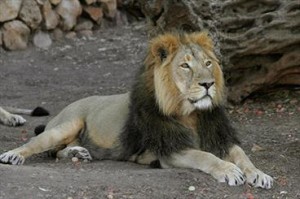 TEHRAN, Feb. 24 (MNA) � A recent BBC documentary �The Last Lions of India� has expropriated Persian Lion and introduced it an Indian lion.
TEHRAN, Feb. 24 (MNA) � A recent BBC documentary �The Last Lions of India� has expropriated Persian Lion and introduced it an Indian lion.I recently watched a documentary named �The Last Lions of India� made by the British Broadcast Corporation (BBC). Watching this documentary grieved me so much, because it reminded me of the old story of confiscating Iran�s cultural symbols and geographical belongings for others.
As those who for some reason don�t like Iran have always tried to change the name of the Persian Gulf to an invalid one; or as those who have repeatedly intended to give Iran�s three Persian Gulf islands, namely Abu Musa, the Greater and the Lesser Tunbs, to a country on the southern margins of the Persian Gulf; now some are trying to change the name of the Persian lion Panthera leo persica to the Indian Lion Panthera leo indiaca.
Therefore I, as an Iranian zoologist, have decided to write this letter to the makers of this documentary in order to inform them of the mistake they have made so that they, as well as apologizing to the people of Iran, can announce the truth to the world and to the international viewers of this documentary.
In the beginning of the documentary, the narrator, Ms. D. Barlow, briefly mentions about the Persian lion�s distribution across the world, saying that �Once the Asiatic Lion used to live in the west of Asia and ancient Greece�; but she never mentions anything about Iran, which is the Persian lion�s origin. It is necessary to understand that before the Persian lion spread out across Asia, it used to exclusively live in the vast areas of Iran such as the forests surrounding Karkheh, Dez, and Karoun rivers, and near Masjed Soleyman, Ramhormoz, Bushehr and Dasht-e Arzhan, west of Shiraz.
Similar to the Caspian tiger, the Persian leopard, and the Asiatic cheetah, the Persian lion is rooted in Iran�s history, culture and art.
The existence of the drawings of the Persian lion in many ancient Iranian works of art such as crafts, tiles, paintings, and even works of literature such as Kelileh va Demneh is the best proof of that fact.
Half way through the documentary, the narrator mentions that the �Nawab of the princely state of Junagadh� and the �British Viceroy of India, Lord G. Curzon� both decided to stop the hunting of the Asiatic Lion and conserve its population, because their numbers were drastically decreasing, with less than 20 individuals extant in 1900. It should be interesting to know that the last Persian lion was seen in Iran in 1942, exactly one year after Iran had been occupied by the Allied troops during the Second World War, an era when all Iranian creatures, including human beings and animals, were being invaded by the foreign troops.
According to evidence, there is no doubt now that the Persian lion became extinct as a result of the inconsiderateness of those occupiers, as they used to hunt the Persian lion as a favorite hobby. The same fate also befell the Caspian Tiger. I am certain that if there had been the likes of Lord Curzon among the occupiers of Iran during WWII, we would not have regretted the loss of the Persian lion and the Caspian Tiger now.
Of course, one should not ignore the inappropriate conduct of the Qajar princes, who indiscriminately hunted down the Persian lion in a Qajar ritual of coming-of-age. Those princes, in order to demonstrate their maturity and physical prowess, were by custom required to shoot down a Persian lion, cut off its head, and present it to the king. This Qajar ritual was the main cause of the decrease in the number of Persian lions in Iran.
At the end of the documentary, Mr. B. Pathak, the field director of Gir Forest National Park, states that �The Asiatic lions have become the pride of the country [India]�. In response, I, as an Iranian zoologist, would say that if the last Persian lion, which was last seen in the northwest of Dezful in Khuzestan province of Iran, had not been hunted, now I could have said, �The Persian lions are the pride of Iran.�
In the end, I must add this with pleasure that the last census report accomplished in 2010 showed that there were 411 Persian lions in Gir Forest National Park, which indicated an increase by 50 of the Persian lion population as compared to the last census report in 2005. It is great news for the lovers of the Persian lion everywhere; and I hope this trend of growth keeps continuing.
By Mehr News Agency�
The Iran Project is not responsible for the content of quoted articles.











